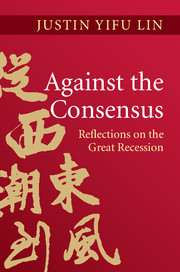Book contents
- Frontmatter
- Contents
- List of figures
- List of tables
- List of boxes
- Preface
- Overview
- Part I What Caused the 2008–9 Global Crisis?
- Part II A Win-Win Path to Recovery
- Part III How Poor Countries Can Catch Up: Flying Geese and Leading Dragons
- 8 The mystery of the great divergence
- 9 The mechanics and benefits of structural change
- 10 Lessons from the failures and successes of structural transformation
- 11 Unique opportunities for poor countries
- Part IV Toward a Brave New World Monetary System
- References
- Index
10 - Lessons from the failures and successes of structural transformation
from Part III - How Poor Countries Can Catch Up: Flying Geese and Leading Dragons
Published online by Cambridge University Press: 05 June 2013
- Frontmatter
- Contents
- List of figures
- List of tables
- List of boxes
- Preface
- Overview
- Part I What Caused the 2008–9 Global Crisis?
- Part II A Win-Win Path to Recovery
- Part III How Poor Countries Can Catch Up: Flying Geese and Leading Dragons
- 8 The mystery of the great divergence
- 9 The mechanics and benefits of structural change
- 10 Lessons from the failures and successes of structural transformation
- 11 Unique opportunities for poor countries
- Part IV Toward a Brave New World Monetary System
- References
- Index
Summary
The insights of early development thinkers such as Akamatsu, Gerschenkron, and Kuznets enriched development knowledge. But they did not answer many of the most burning questions facing policymakers in developing countries.
Arthur Lewis, observing that “the central problem in the theory of economic development is to understand how a community that was previously saving and investing 4 or 5 percent of its national income or less converts itself into an economy where voluntary saving is running at about 12 to 15 percent of national income or more,” concludes that “the central fact of economic development is that the distribution of incomes is altered in favor of the saving class.” His analysis assumed that saving is a prerequisite to sustained growth. This is not necessarily so. But, even assuming that it is, a key question for structural transformation remains how to foster capital accumulation in poor countries.
Besides the saving constraint, some researchers have introduced foreign exchange requirements or human capital as additional limitations to economic growth. Again, taking these assumptions as true, the question of how to overcome such obstacles remains unanswered.
Other important questions for the structural change agenda concern how to facilitate enterprise clustering to produce economies of scale and how to facilitate the emergence of “leading sectors” that can propagate growth and links to other industries. Even in resource-rich countries there have been many instances of fast growth based on the exploitation of natural resources that did not lead to structural transformation – notably when employment in the industrial sector did not expand rapidly enough to absorb a growing labor force. Well-known cases include mineral-rich African countries such as Chad, the Republic of Congo, the Democratic Republic of Congo, Gabon, Guinea, Niger, and Sudan.
- Type
- Chapter
- Information
- Against the ConsensusReflections on the Great Recession, pp. 123 - 132Publisher: Cambridge University PressPrint publication year: 2013



